Art & Tech
10 Predictions About Unexpected Ways A.I. Will Reshape Art (Part 2 of 2)
Machine sabotage, extreme appropriation, and heady nostalgia.
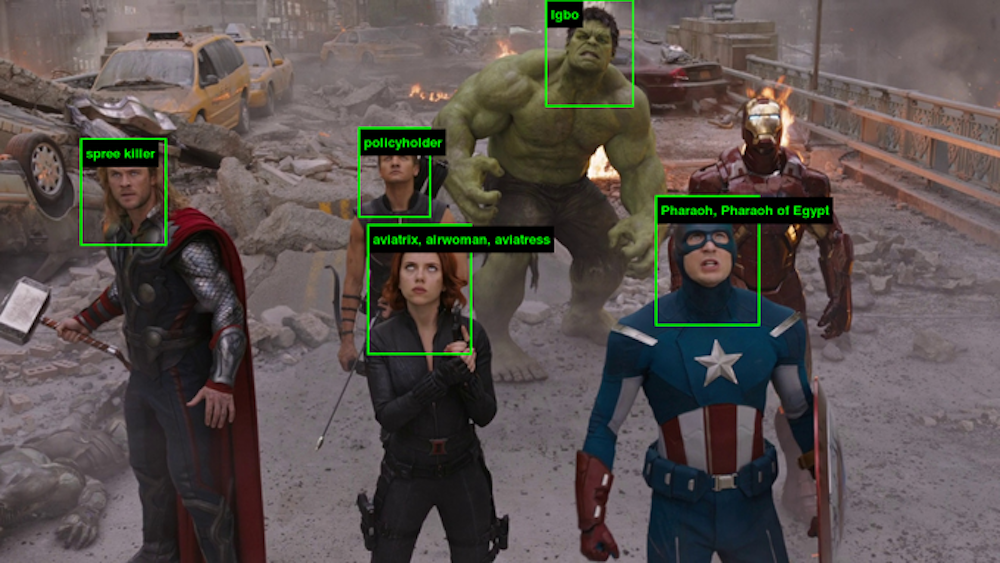
Machine sabotage, extreme appropriation, and heady nostalgia.

Ben Davis

This is the second part of a two-art essay speculating wildly about the impact of A.I. on artmaking. The first part is here.
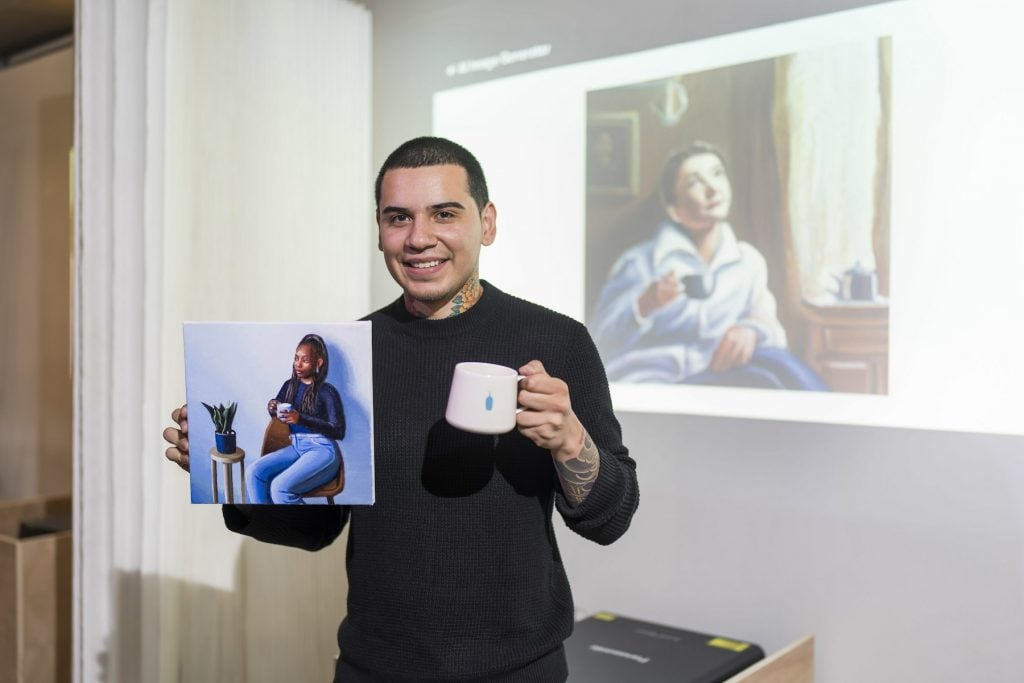
Devon Rodriguez paints alongside A.I.-generated art at Blue Bottle Coffee’s “The Human-Generated Art Experiment” in New York City on October 25, 2023. (Ben Hider/AP Images for Blue Bottle Coffee)
Devon Rodriguez, whose TikTok videos of himself sketching people on the subway have made him into one of the world’s most-popular artists, ended the year with a partnership with Blue Bottle Coffee. It was dubbed the “Human-Generated Art Experiment.” For the event, he faced off with an A.I. art generator to see whether he or the A.I. could create the more soulful image of someone drinking coffee.
“Attendees witnessed the two vastly different processes in real-time as Rodriguez brought to life his realist oil painting over seven hours,” the press release from Blue Bottle explains. “Viewers also learned about the brand’s 20+ years of artistry in deliciously crafted coffee to inspire them to incorporate the ritual of pour over coffee into their morning routines.”
The event caught my eye because Rodriguez is a big example of what I call “parasocial aesthetics”—that is, an art practice where the public’s attachment to the artist as a character is as important, or more important, than interest in the quality of the artworks themselves. So it’s telling that he’s the artist chosen to pit against A.I.
If parasocial relationships were important in the Influencer Art era, they are going to be much more important in the A.I. Art era.
What is left when an A.I. can quickly abstract your characteristic mode of expression and spit out something that looks exactly like you made it? The answer is just you, the person, and your actual lived connection to your own image as a maker. The logical corollary of ubiquitous creative A.I. is the ubiquity of the artist themself, as a character.
When so much of the creative work is being done automatically, the viewer is going to want to literally see the artist at work, to understand what the character of the human part of the creative process truly is. Being a visible personality is going to be indispensable to a successful artistic practice—no matter what kind of artist you are.
And yes, it is possible to fake an online presence via A.I. avatars and custom chatbots. You would expect lots of this—and then lots of backlash to it, since, again, the actual luxury is going to be verifiable connection to humanity.

Screenshot from Hbomberguy’s blockbuster YouTube essay “Plagiarism and You(Tube).”
YouTube has been obsessed these past weeks with an almost-4-hour video essay by one “Hbomberguy,” detailing the plague of plagiarism in YouTube video essays. He shows how lucrative content empires are built on just taking documentaries that were years in the making, lifting their entire script and reading it over stock images. Or by passing off other people’s research and turning it into a lecture, pretending to have studied the topic.
Hbomberguy shows how low-effort these content heists are, illustrating how scripts are word-for-word the same, side by side. Unfortunately, generative A.I. is specifically designed to take low-effort content-jacking to new heights of speed and convenience, as Hbomberguy notes at around the 3:40 time stamp in his video. After all, these systems are based on appropriating the world’s culture to train themselves with, for free!
I would expect whole new artforms based on real-time remixing. But given the reality that, when taken to its logical endpoint, that type of instant-appropriation culture implodes the internet by destroying most of the incentive to actually make original work, I would also expect much more extensive levels of ambient paranoia, resentment, and acrimony about what aspects of expression are original or stolen, and what constitutes acceptable credit, and who benefits. And almost certainly a lot more paywalls.
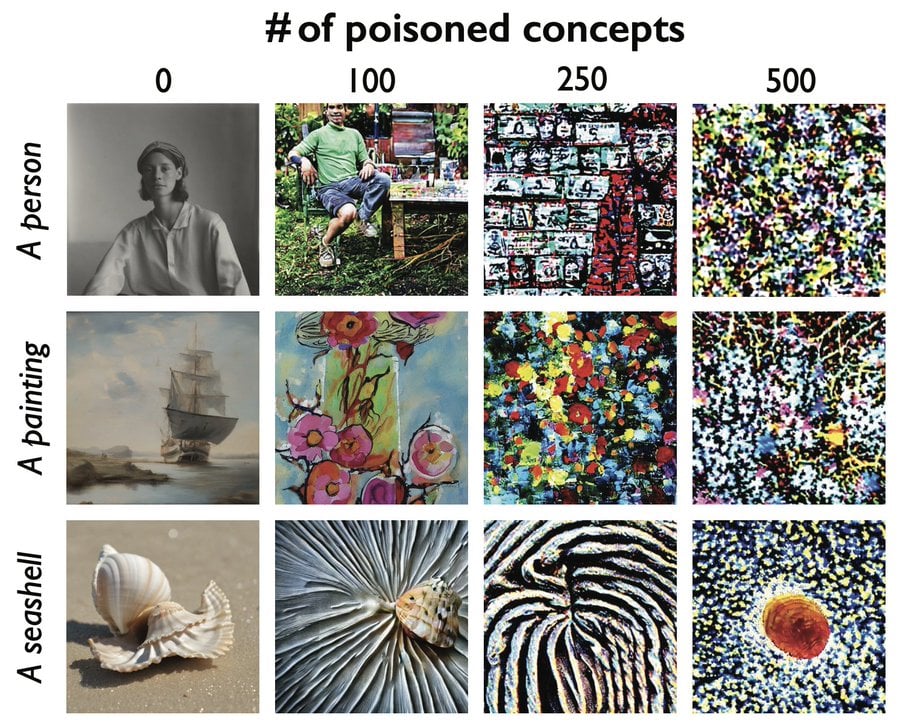
Image illustrating the effects of Nightshade.
Whatever its promises of glorious utopian productivity, A.I. is going to enter many, many people’s lives—artists among them—as a wildly disruptive force, pushed by unscrupulous and insensitive corporate forces, with all the resulting negative cultural associations. So, while I imagine a large number of people making stuff with A.I., I also imagine that some very visible art will be about trying to break it, undermine it, hack it, and expose its limits to scrutiny.
This was already a dominant tendency among artists long before the new A.I.-art wave, à la Kate Crawford and Trevor Paglen’s ImageNet Roulette of 2019, which now looks prophetic, and actually did provoke widespread conversation about the biases of A.I. training sets (and even some action). Crawford and Vladan Joler, incidentally, currently have an important installation at the Fondazione Prada, “Calculating Empires,” on the history of technology’s relation to systems of power, as a warning about A.I.’s potentially malign impacts today.
This year, even as generative A.I. has surfed a wave of foaming hype, projects like Nightshade have gotten as much or more attention as almost any individual A.I. artwork. Created by a team of researchers including Ben Zhao at the University of Chicago, Nightshade is a tool that aims to let artists “poison” A.I. that is trained on their art without permission, with the end of undermining these systems.
Mat Dryhurst and Holly Herndon are our premier A.I.-art gurus, having done major work to think through the technology thoughtfully with their Holly+ project, which creates a digital doppelgänger of Herndon’s voice that would-be musical collaborators can work with. Yet in this year of A.I. breakthroughs, they have received the most public attention for Spawning.ai, their initiative to let artists opt their art out of A.I. and theoretically take back some control.
Now that A.I. image tools are not just an interest for the specifically tech-minded and are being aggressively pushed into every possible corner of contemporary life, you might expect artist efforts to radicalize from “provoking conversation” to actual disruption.
Of course, we’re talking about giant technological interests, so meaningful disruption is very, very hard, even at the margins. But, again, it’s what is hard to do that feels like “art.”
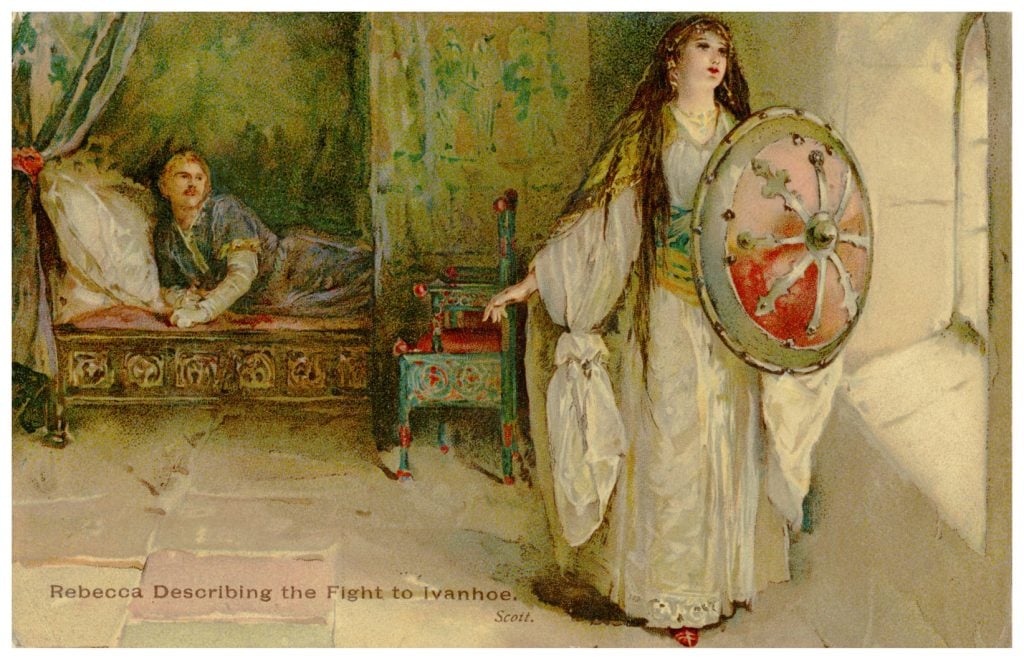
Illustration of Ivanhoe by Sir Walter Scott, published 1819. (Photo by Culture Club/Getty Images)
As A.I. turbo-charges the production of endlessly new, ultra-personalized images, I can’t help but think that this pushes valuation systems towards the old. The accent falls on resources that cannot be generated infinitely, types of culture that have real human histories and established, shared memories around them. You’re going to have a lot of pre-A.I. nostalgia.
Art history has a tendency to shift around as new technologies rewrite values. Medieval art was considered primitive and associated with the cultural decay of the so-called “Dark Ages”—until the Medieval Revival in 19th century Britain. The Industrial Revolution brought a great deal of squalor and historically new forms of alienation, both at work and in the goods one consumed. In turn, that sparked a new interest among the intellectual class for the handmade, for craft production—and for the imagined romance of pre-modern times. (This even took a political, socialist coloring in William Morris’s Arts and Crafts movement.)
I don’t know exactly what types of crafts or which exact past era the contemporary imagination might turn to for grounding inspiration. A lot of recent energy has gone into a romance of occult art and mystical systems, clearly responding to digital dehumanization. And the New York Times is talking about how blacksmithing is “in” now…
But I would anticipate a lot of art based on some kind of new-model historical revivalism, probably with an intensity in exact proportion to however disruptive this A.I. wave actually turns out to be. And I would expect the value of antiques to go up.
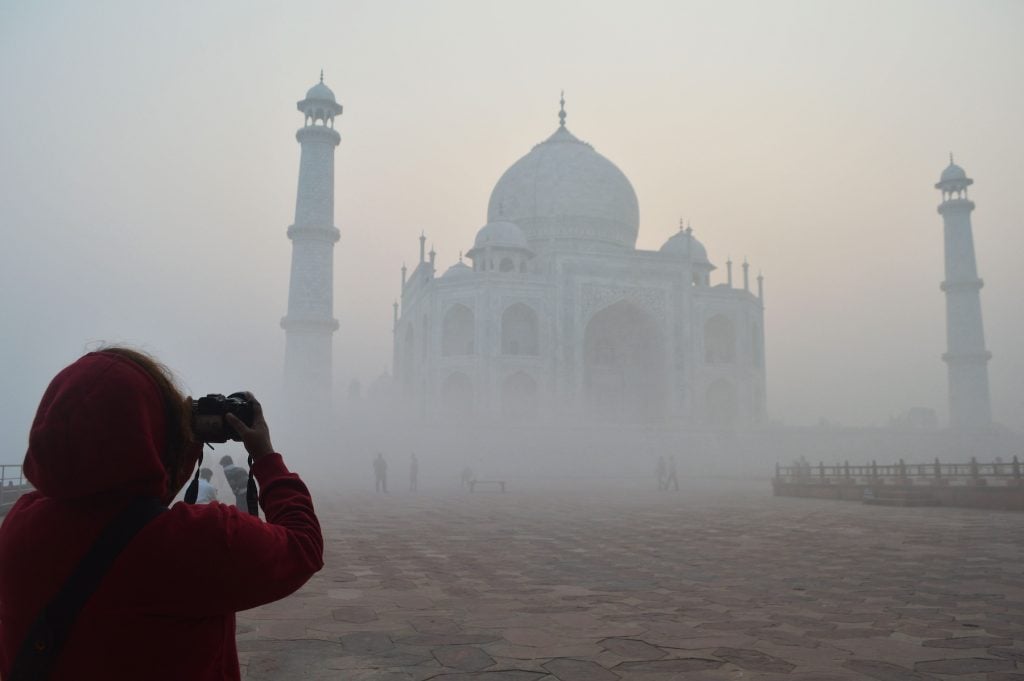
A tourist takes a picture of the Taj Mahal. No photos allowed inside the main mausoleum. (Photo by Pawan Sharma / AFP, via Getty Images)
In a recent podcast with Joshua Citarella, philosopher Benjamin Bratton hypothesized that just as Instagram caused artists to view their artworks as potential photo backdrops for social display, A.I. generators are likely to make artists view their artworks through the lens of being potential training data for A.I. models.
Whether you are reacting with or against this situation, that is the reality as it stands at the end of 2023. Once a given artistic image enters the zone of visibility to the data-scrapers, it becomes not a discrete, authored work but a resource to be abstracted and recombined; raw material to be immediately referenced; one insignificant point in a sea of infinite variants, out of one’s control.
“I see the individual ‘genius’ losing status, moving towards a symbiotic, cyber state with other cells, structures, roots, networks and organisms,” artist Marianna Simnett told my colleague Min Chen recently, speaking of the impact of A.I. She sees this as a good thing—but for those artists who want to experience themselves as creators who still have some kind of special, individual identity, this might be done through some form of opting out of digital space itself.
A decade ago, there was a robust theoretical conversation about the errors of “digital dualism” (Nathan Jurgenson’s term), the belief that “real life” was somehow opposed to “digital life,” when actually the two interpenetrate in all kinds of profound ways. But I’d guess that as digital space becomes more dominated by inhuman actors, people might want to reestablish some kind of “performative digital dualism,” to create spaces where images aren’t experienced as training assets immediately sucked up into the A.I. stream.
Of course, the sense of the absolute specialness of an IRL encounter with an artwork is in some ways a mystification, a story we tell ourselves. If the present situation presses viewers of art towards a taboo on recreating certain images in forms accessible outside the particular cult of their presence, then we are essentially reverse-engineering some kind of sacred experience of art, for the extremely desacralized A.I.-art age.
More Trending Stories:
Art Dealers Christina and Emmanuel Di Donna on Their Special Holiday Rituals
Stefanie Heinze Paints Richly Ambiguous Worlds. Collectors Are Obsessed
Inspector Schachter Uncovers Allegations Regarding the Latest Art World Scandal—And It’s a Doozy
Archaeologists Call Foul on the Purported Discovery of a 27,000-Year-Old Pyramid
The Sprawling Legal Dispute Between Yves Bouvier and Dmitry Rybolovlev Is Finally Over